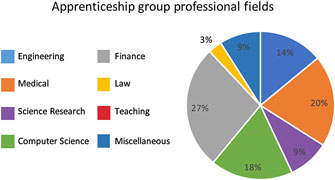Article contents
The effect of university research apprenticeships for high school students on Science, Math, Engineering, and Technology learning and the pursuit of Science, Math, Engineering, and Technology degrees and careers
Published online by Cambridge University Press: 09 May 2018
Abstract

The goal of this study is to examine whether participation in high school research apprenticeships increases pursuit of degrees and careers in science, and to explore other apprenticeship benefits. Students who participated in a research apprenticeship were surveyed about its influence on their undergraduate, graduate, and professional decisions. A control group who attended the same high schools, had similar grade point averages, and graduated with the apprenticeship participants was also surveyed. It was found that a significantly higher fraction of the apprenticeship group majored in Science, Math, Engineering, and Technology (STEM) fields, pursued careers in STEM disciplines, and found the experience to strategically influence their job performance.
Information
- Type
- Prospective Articles
- Information
- Copyright
- Copyright © Materials Research Society 2018
References
- 4
- Cited by


